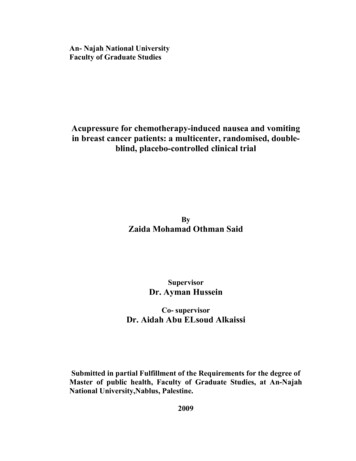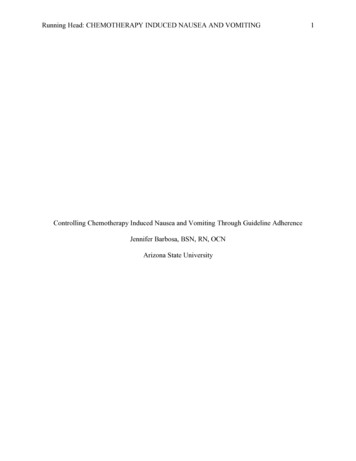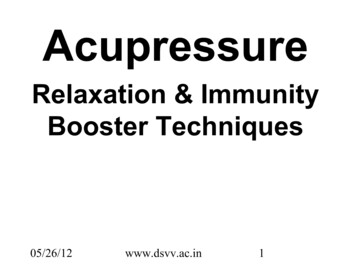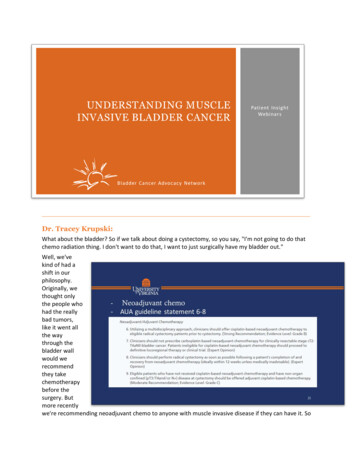
Transcription
An- Najah National UniversityFaculty of Graduate StudiesAcupressure for chemotherapy-induced nausea and vomitingin breast cancer patients: a multicenter, randomised, doubleblind, placebo-controlled clinical trialByZaida Mohamad Othman SaidSupervisorDr. Ayman HusseinCo- supervisorDr. Aidah Abu ELsoud AlkaissiSubmitted in partial Fulfillment of the Requirements for the degree ofMaster of public health, Faculty of Graduate Studies, at An-NajahNational University,Nablus, Palestine.2009
iiiDedicationDedicated to------My parents and all my familly with consistant love
ivAcknowledgmentI would like to express my special thanks to Dr. AidahAlkaissi and Dr. Ayman Hussein for their supervision, withouttheir endless support this work was difficult to achieve.I would like to express my the thanks to the ministry ofhealth of Palestine, and for the hospital mangers and nursingdirector (Al Wattani, Jenin, and Beit Jallah hospitals) forproviding the facilities to conduct this study.I would like also to express my thanks to the oncologists(Dr. Yousef Horani, & Dr. Abed El- Rasiq Salhap for their cooperation.My thanks extended also to all who helped me in of the datacollection of this studyMy deep appreciation goes to my parents, brothers, andsisters for their encouragements and support.
v "ﺇﻗــــﺭﺍﺭ" ﺃﻨﺎ ﺍﻟﻤﻭﻗﻊ ﺃﺩﻨﺎﻩ ﻤﻘﺩﻡ ﺍﻟﺭﺴﺎﻟﺔ ﺍﻟﺘﻲ ﺘﺤﻤل ﺍﻟﻌﻨﻭﺍﻥ : ﻤﺩﻯ ﺘﺄﺜﻴﺭ ﺃﻷﺴﺎﻭﺭ ﺍﻟﻀﺎﻏﻁﺔ ﻓﻲ ﻤﻨﻊ ﺍﻟﻘﻲﺀ ﻭﺍﻟﻐﺜﻴﺎﻥ ﻋﻨﺩ ﻤﺭﻴﻀﺎﺕ ﺴﺭﻁﺎﻥ ﺍﻟﺜﺩﻱ ﻭﺍﻟﻠﻭﺍﺘﻲ ﻴﺨﻀﻌﻥ ﻟﻠﻌﻼﺝ ﺍﻟﻜﻴﻤﺎﻭﻱ Acupressure for chemotherapy-induced nausea and vomiting in breast cancer patients: a multicenter, randomised, double blind, placebo-controlled clinical trial ﺹ ، ﺒﺎﺴﺘﺜﻨﺎﺀ ﻤﺎ ﺘ ّﻤﺕ ُﺃﻗ ّﺭ ﺒﺄﻥ ﻤﺎ ﺍﺸﺘﻤﻠﺕ ﻋﻠﻴﻪ ﻫﺫﻩ ﺍﻟﺭﺴﺎﻟﺔ ، ﺇﻨﹼﻤﺎ ﻫﻭ ﻨﺘﺎﺝ ﺠﻬﺩﻱ ﺍﻟﺨﺎ ّ ﻱ ﺠﺯﺀ ﻤﻨﻬﺎ ، ﻟﻡ ﹸﺘﻘ ّﺩﻡ ﻤﻥ ﻗﺒل ﻟﻨﻴل ﺃ ّﻴﺔ ﺩﺭﺠﺔ ل ﺃﻭ ﺃ ّ ﺍﻹﺸﺎﺭﺓ ﺇﻟﻴﻪ ﺤﻴﺜﻤﺎ ﻭﺭﺩ ، ﻭﺃﻥ ﻫﺫﻩ ﺍﻟﺭﺴﺎﻟﺔ ﻜﻜ ّ ﻲ ﺃﻭ ﺒﺤﺜ ّ ﺃﻭ ﻟﻘﺏ ﻋﻠﻤ ّ ﻲ ﻟﺩﻯ ﺃ ّﻴﺔ ﻤﺅﺴﺴﺔ ﺘﻌﻠﻴﻤ ّﻴﺔ ﺃﻭ ﺒﺤﺜ ّﻴﺔ ﺃﺨﺭﻯ . Declaration The work provided in this thesis, unless otherwise referenced, is the researcher’s own work, and has not been submitted elsewhere for any other degree or qualification. ﺍﺴﻡ ﺍﻟﻁﺎﻟﺏ : ﺍﻟﺘﻭﻗﻴـﻊ ﺍﻟﺘﺎﺭﻴـﺦ : Student’s Name: Signature: Date:
viACRONYMS5HT5 Hydroxy Tryptamine (serotonin)5-HT35-hydroxytryptamine 3NK1 receptorNeurokinin1-ReceptorNVNausea & Vomiting5-HIAA5-hydroxyindoleacetic acidNTSNucleus Tractus SolitariusCINVChemotherapy-Induced Nausea and VomitingCIVChemotherapy Induced VomitingCSFCerebro Spinal FluidsQOLQuality of LifeANSAutonomic Nervous SystemMOHMinistry of HealthTENSTranscutaneous Electrical Nerve StimulatorASCOThe American Society of Clinical OncologyTCMTraditional Chinese Medicine
viiList of ContentContentDedicationAcknowledgmentAcronymsList of contentList of tablesList of 4.11.1.4.21.1.4.31.1.51.1.5.11.1.5.22.12.22.32.42. 52.62.6.12.6.22.733.1PageiiivviixxxiChapter OneDefinition of termsIntroductionBack groundMechanism of chemotheray induced vomitingMechanism of substance PChemotherapyDoxorubicinAcupuncture and acupressureAcupressure mechanismPhysiological aspect of acupuncture and NVStimulationAnti emetics5 H3 receptor er Tow: Literature ReviewStudies with Positive FindingsStudies with Negative FindingsStatement of the ProblemThe Importance of the StudyHypothesisObjectivesThe primary objectiveThe secondary objectivesStudy Outcomes222727282929293030Chapter Three: MethodologyMaterials and MethodsDesign3133
153.163.17ContentInclusion criteriaExclusion criteriaInformed consentPeriod of the studyRandomizationBlindnessProphylactic antiemetic treatmentSettingInterventionMeasuresQuality of life instrumentAfeedback questionnaireAssessment of patient satisfactionPruceduresStatistics and analysisEthical consideration4.104.11Chapter Four: Results& AnalysisDemographic dataRisk factors for nausea and vomitingThe incidence of vomiting and retching and thefrequency of vomiting- day 1The incidence of delayed vomiting episodes day2-5Incidence vomiting/ retching, frequency ofvomiting, incidence of acute nausea, and nauseaseverity: Study day 1Incidence of delayed nauseaAccumulative incidence of delayed nauseaDelayed emetic episodesRequirement of rescue anti-emetics in thedifferent groups (1-5 daysAnalysis of patient QOLPatient satisfaction5.15.2Chapter Five: DiscussionMethods discussionResults 3343434353536373737393941434344454646474848495053
ix6.16.2AppendixAAppendixBAppendixCContentChapter Six: Conclusion and pedixFunctional Assessment of Cancer Therapy-G(FACT-G)functional assessment of chronic illness therapy(DACT) licensing agreementPatient self assessment tool(Questionnaire) الملخص Page606063828486 ب
xList of TablesTable NoTable4.1.Table 4.2.Table 4.3.Table 4.4.Table 4. 5.Table 4.6.Table 4.7.Table 4.8.Table 4.9.Table 4.10.Table 4.11.ContentPageDemographic characteristics of patients in41treatment groupsRisk factors for nausea and vomiting were divided 42into treatment groupsIncidence & severity of nausea, vomiting/retching42of patients in the treatment groups during first 24 hfollowing chemotherapyIncidence of delayed vomiting episodes: Days 2-5,44n (%) in the three groups after chemotherapySeverity of delayed nausea Days 2-5 in the three45groups. Values given as Mean (SD)Incidence of delayed nausea Days 2-5 in the three46groups, values given in a dichotomous fashion(yes or no)Accumulative incidence of delayed nausea Days462-5 3 (0-6 scale) of moderate to very severenature in the three groupsNumber of delayed emetic episodes Days 2-5 in47the three groups. Values given as Mean (SDRequirement of rescue anti-emetics in the three48group’s days 1-5Comparison of the study outcomes by Analyses of48QOL by using FACT-GOverall patients satisfaction with acupressure and49if they would recommend other patients to wearbands when receiving chemotherapy
xiList of FigersFiger NoContentFigure 1.The locationof pericardiumP6 point(Neigumn)andposition of acupressure Band in both Active(acupressure) and a non acopoint (placebo) groups.Alkaissi et al 2002Page32
xiiAcupressure for chemotherapy-induced nausea and vomitingin breast cancer patients: a multicenter, randomised, doubleblind, placebo-controlled clinical trialByZaida Mohamad Othman SaidSupervisorDr. Ayman HusseinCo- supervisorDr. Aidah Abu Elsoud AlkaissiAbstractPurpose: To examine the efficacy of P6-acupressure in preventingchemotherapy- induced nausea and emesis associated with highlyemetogenic chemotherapy (i.e. doxorubicin as adjuncts to standard 5-HT3receptor antagonist (granisetron) and dexamethasone as antiemetic given aspart of routine care in reducing acute nausea (during the day of treatment)and delayed nausea (2-5 days) following the day of chemotherapy. Thesecond aim is to examine the efficacy of the acupressure bands withstimulation of P6 in reducing vomiting and in maintaining Quality of Life(QOL).Patients and methods: A randomized, double-blind, placebo controlledtrial. One group received acupressure with bilateral stimulation of P6(n 42), a second group received bilateral placebo stimulation, (n 42) and athird group received no acupressure wrist band and served as a controlgroup, (n 42). Acupressure was applied using a Sea-Band (Sea- Band UKLtd., Leicestershire, England) that patients to wear for the 5 days followingthe chemotherapy administration. Assessments of acute and delayed nauseaand emesis, quality of life(OOL), patients’ satisfaction, recommendation oftreatment and requirement of rescue antiemetic were obtained.
xiiiResults: Significant difference was found in the severity of early nausea 3(0-6 scale) in the acupressure group M (SD) 1.62 (2.04) as compared toplacebo group 2.17 (2.09), p 0.0006.Astatically significant decrease was found with the proportion of ingchemotherapy 3(0-6) scale in the acupressure group,43%(18/42)ascompared to placebo group,67%(28/42), p .0284. Table 4.3The acupressure group had a statistically significant reduction in theincidence of delayed nausea 40% (17/42) as compared to the control group62% (26/42) (p 0.0495). Further analyses indicated that significantdifference existed in the intensity of delayed nausea by acupressure groupM (SD) 1.45 (1.73), p 0.0002 as compared to control 2.03 (1.91).Significant difference also existed in the intensity of delayed nausea byplacebo group 1.33 (1.66), p 0.0010 as compared to control 2.03 (1.91).Here a placebo effect was noted.Astatically significant decrease was found with the proportion of patientswho had a moderate to very sever nausea days 2-5 3(0-6) scale, in theacupressure group,55%(23/42),(p 0.0206),and in the placebo group52%(22/42), p 0.0116,as compared to the control group79% (33/42). Aplaceboeffect was noted.The mean number of delayed emetic episodes days 2-5 was significally lessin the acupressure groupM(SD) 2.7(1.87) as compared to placebo 3.3(1.9),p 0.0022 and control group 2.07(1.20), p 0.0005
xivRequirement of rescue antiemetic was significantly lower in P6acupressure (55%, 23/42), as compared to control group (76%, 32/42) (p 0.0389).Eight one percent (35/42) of the patients in acupressure group weresignificantly satisfied with P6-acupressure as compared to placebo group64% (27/42), p 0.0471. Seventy nine percent (34/42) of the patients inacupressure group would recommend P6-acupressure to another patients ascompared to placebo group 62% (26/42), p 0.0533 .CONCLUSIONS: P-6 Acupressure is efficacious for the control ofdelayed chemotherapy induced nausea and emesis and is a value-addedmethod in addition to pharmaceutical management for women undergoingtreatment for breast cancer.
1Chapter One1. INTRODUCTIONCancer (Ca) is a group of diseases characterized by uncontrolled andgrowth spread of abnormal cells. It may be caused by internal factors(inherited mutation, hormonal, immune, conditions and mutation frommetabolism) or external ones (tobacco, radiation, chemicals and infectiousorganisms) (Kumark and Clark, 2005). Cancer is prevalent all over theworld among developed and developing nations; it affects both sexes at allages. Breast cancer is the first leading cause of death of female cancers.Over 175,000 women in the US are diagnosed with breast cancer each year,the prevalence rising up to 7% over age 70 in the near future (LouWman etal., 2007). It occupies the first of female’s Ca among the Palestinians withincidence (15.1) per 100,000 population, and mortality rate (5.2) per100,000 females (MOH report, 2005). Ca treatment is based onchemotherapy, radiotherapy and surgical interventions. Radiotherapy isavailable at Auqasta vectoria hospital(AVH) at Al-Alquds in thePalestinian territories, but the other two types are accessible at mostgovernmental health settings at Gaza Strip and West Bank (WB).Chemotherapy is an important treatment in cancer care and isassociated with numerous side effects such as bone marrow suppression,increased susceptibility to infection, nephrotoxicity, anorexia, alopecia, cupress, nausea and vomiting (Vincent et al., 2001). Early studiesreported that patients cited nausea and vomiting as the most distressingsymptoms when receiving chemotherapy (Coates et al., 1983; DeboerDennert et al., 1997). Beyond their distressing effects, sever nausea and
2vomiting can lead to nutritional deficiencies, dehydration and electrolyteimbalance and fatigue (Hawthorn 1995, Joss et al., 1990; king 1997).Historically, antiemetic treatment has been improved first by theintroduction in 1981 of high-dose metoclopramide which reduced theamount of emesis (Gralla et al., 1981), second by the development ofserotonin (5-HT3) antagonist in the early 1990s, potentiated byconcomitant use of corticosteroids which further improved control ofemesis (Grunberg & Kesketh, 1993). Despite these improvements, nauseaand vomiting remain a problem for patients. Recently a new drug, theneurokinin NK (1) receptor antagonist has been shown to have a bettereffect on preventing both acute and delayed CINV for patients treated withhighly emetogenic chemotherapy (Dando & Perry, 2004; Dewit et al.,2004). Non-pharmacological interventions such as music (Ezzone et al.,1998), acupressure (Dibbel et al., 2000) and progressive muscle relaxation(Molassiotis et al., 2002) have also been shown to reduce CINV.The 5-HT3 antagonists are more effective than prior medications inpreventing chemotherapy induced vomiting (DeMulder. 1990; Marty,1990; Roscoe et al., 2000; Osoba et al., 1997). However, chemotherapyrelated nausea is not as well controlled by these drugs and remains asignificant problem (Roscoe et al., 2000). Uncontrolled nausea andvomiting (NV) can interfere with adherence to treatment regimens, andmay cause oncologists to reduce chemotherapy doses (Morrow and Dobkin1988; Stewart, 1990). Nausea and vomiting can also disrupt the activitiesof daily living, cause lost time from work, increase anxiety and depression,(King, 1997).
3In one study involving 1,413 cancer patients undergoing chemotherapy,80% experienced nausea to some degree, with 40% having at least oneepisode of vomiting (Roscoe et al., 2000). Similarly, in a study, 76% of322 patients who received chemotherapy regimens containing cisplatin,carboplatin, or doxorubicin experienced nausea following their firsttreatment, despite what was felt by physicians to be adequate antiemeticprophylaxis. Of these 322 patients, 147(46%) had nausea of moderate tosevere (Hickok et al., 2003). Identifying methods to successfully preventand alleviate treatment-related nausea remains a major clinical challenge.Since pharmacological treatments have failed to completely manageNV, exploring the complementary role of other, non-pharmacological,approaches that can be used in addition to pharmacological approachesbecomes paramount. Acupressure at the P6 point is a value-addedtechnique in addition to pharmaceutics; management for womenundergoing treatment for breast cancer to reduce the amount and intensityof delayed CINV, since up to 60% of patients had been reported nauseadespite the use of anti emetics (Dibble et al., 2007). Interestingly, severalstudies reviewed by Morrow and Roscoe (1997) have found that women,compared to men, are more susceptible to nausea caused by classicalconditioning, as evidenced by the fact that women are more likely toexperience nausea in anticipation of chemotherapy.Stimulation of the P6 acupuncture point located on the inside of thewrist with needles (acupuncture) or pressure (acupressure) has been used torelieve NV in Traditional Chinese Medicine (TCM) for centuries (Beinfield andKorngold, 1995). Literature reviews indicate that acupuncture andacupressure may provide relief of these symptoms (Kaptchuk, 2002;
4Mayer, 2000; Vickers, 1996). Specifically, needling or applying pressure(generally with an acupressure band such as the Sea Band , (Sea Band UKLtd., Leicestershire, England) to an acupoint have been efficacious inalleviating morning sickness (Belluomini et al, 1994; Carlsson et al., 2000;De Aloysio and Penacchioni, 1992; Norheim et al., 2001; Evans et al.,1993; Slotnick, 2001), motion sickness (Hu, 1992, 1995; Bertolucci andDiDario, 1995; Stern et al., 2001; Alkaissi 2005), post-surgical nausea (Fanet al., 1997; Ferrara-Love et al., 1996; Gieron et al., 1993; Harmon et al.,2000; Ho et al., 1996; Stein et al., 1997; Alkaissi 1999, 2002; Zarate etal., 2001) and NV associated with chemotherapy (Dundee 1989,1991;Roscoe, 2002, 2003; Shen et al., 2000; Dibble, 2000; Williams et al.,1992;Treish et al., 2002; Bushunow et al., 2002; Dundee and Yang; 1990;Stannard, 1989; Pearl et al.,1999; Noga et al., 2002).Beginning in the early 1990s, studies assessing the efficacy ofelectrical stimulation (acustimulation) using portable TranscutaneousElectrical Nerve Stimulator (TENS) Wrist Bands to the P6 acupuncturepoint for control of nausea have also been conducted. All of these studiesused the Relief Band (Woodside Biomedical, Carlsbad, CA), which ismarketed for this purpose and has United States Food and DrugAdministration (FDA) clearance as treatment for NV. In 1998, the NationalInstitutes of Health Consensus Statement on Acupuncture concluded thatpromising results have emerged showing the efficacy of acupuncture inadult postoperative and chemotherapy induced nausea and vomiting. Theacupuncture point, P6 had been the point used in most of the trials (Ezzo etal., 2006).
5Acupressure seems to be a good way to complement antiemeticpharmacotherapy, as it is safe, convenient and with minimal costs involved.These make it a cost-effective intervention. It is not known whyacupressure works, and partly these results may be attributed to a placeboeffect, as also highlighted in the study by (Roscoe et al., 2003; Burish etal.,1992) declared that psychological reasons may also partly explain theseresults. Indeed, it was previously reported that relaxation and distractiontechniques have significantly improved nausea and vomiting in breastcancer patients receiving chemotherapy (Molassiotis, 2002). Acupressure iseasily learnt and taught and patients should be informed about its potentialrole and taught how to apply it. Self-administered acupressure appears tohave a protective effect for acute nausea (Ezzo, 2007).There have been recent advances in chemotherapy-induced nauseaand vomiting using 5-HT3 inhibitors and dexamethasone. However, manystill experience these symptoms, and expert panels encourage additionalmethods to reduce these symptoms (Ezzo et al., 2007). Research supportsthe effectiveness of acupuncture and acupressure for the treatment ofchemotherapy-induced nausea and vomiting. Used in conjunction withcurrent antiemetic drugs, acupuncture and acupressure have been shown tobe safe and effective for relief of the nausea and vomiting resulting fromchemotherapy (Collins, 2004).Studies have confirmed that the key to successful management ofCINV is to prevent symptoms before they occur (Goodman 1997; Morrowet al 1998). Assessment evaluation of a cancer patient’s general conditionand a determination of how he or she feels is the first step in managingsymptoms (Dodd et al 2001). Different approaches to symptom assessment
6may be adapted, from unstructured communication between patients andhealthcare professionals to the use of documentation such as checklists ordiaries. Research suggests that systematic assessment of symptoms isassociated with reduced symptom distress over time (Sarna 1998).Chemotherapy-induced nausea and vomiting is classified as either“acute” within 24 h post chemotherapy or “delayed” nausea that occurs ondays 2–5 of the chemotherapy cycle is particularly troublesome becausethere is no reliable pharmacological treatment for this problem (Morrow etal., 1996, 1998). The American Society of Clinical Oncology (ASCO)recommendations include giving potential 5-HT3 receptor antagonists pluscorticosteroids before chemotherapy to patients receiving chemotherapythat are at high risk of emesis. Nevertheless, many patients still experiencenausea and vomiting related to chemotherapy. Therefore, the expert panelsemphasize the need for evaluation of additional ways to reduce thesesymptoms (Gralla et al., 1981; Hesketh et al., 1998). The need foradditional relief has led to interest in non-pharmacological adjuncts todrugs like acupuncture or acupressure. Combining anti emetics with othernon-pharmacological treatments may prove more effective in decreasingnausea than anti emetics alone (Molassiotis et al., 2006).The first aim of this study is to examine the efficacy of P6-acupressure inpreventing chemotherapy induced nausea and emesis associated withhighly emetogenic chemotherapy (i.e., doxorubicin as adjuncts to standard5-HT3 receptor antagonist antiemetic (granisetron) and dexamethasone inreducing acute nausea (during the day of treatment) and delayed nausea (25 days) following the day of chemotherapy).
7The second aim is to examine the efficacy of the acupressure bandswith stimulation of P6 in reducing vomiting and in maintaining quality oflife (QOL).1.1 BACKGROUND1.1.1. Mechanisms of Chemotherapy induced vomiting (CIV):SerotoninThe neurotransmitter serotonin (5-hydroxytryptamine or 5-HT) hasbeen shown clinically to be an important mediator of the early (“acute”)phase of CIV.Preclinical studies have shown that cisplatin causes acalcium-dependent exocytic release of serotonin from enterochromaffincells in the gastrointestinal tract, possibly as a result of free radicalgeneration (Andrews, 1998; Matsuki, 1993). The released serotonin thenactivates receptors on vagal afferent fibres, which stimulates the CNScentres that mediate the emetic response (Andrews, 1998; Matsuki, 1993).These receptors are known to be of the 5-HT3 subtype, as 5-HT3 receptorantagonists inhibit the acute emetic response in a ferret CIV model (Costallet al., 1986; Miner & Sanger, 1986), an observation which generatedfurther interest in the role of serotonin.Cisplatin administration to humans has also shown clear evidence forthe involvement of serotonin. After cisplatin administration, there ensues alarge increase in the urinary output of the serotonin metabolite 5hydroxyindoleacetic acid (5-HIAA) within 24 h indicating the release ofintracellular serotonin (Cubeddu, 1996). The time course of this response inthe acute CIV period appears to correlate well with the clinical efficacyprofile of 5-HT3 receptor antagonists, which are most active against the
8acute-phase CIV associated with cisplatin-based chemotherapy (Cubeddu,1996).Although the predominant therapeutic effect of 5-HT3 receptorantagonists is believed to be antagonism of peripherally released serotonin,a central effect cannot be completely excluded. 5-HT3 receptors have beenshown to exist in the area postrema NTS, sub nucleus gelatinous and inlower densities in the dorsal motor nucleus of the vagus and the spinaltrigeminal tract of a number of species including man (Barnes et al., 1990;Leslie et al.,1990; Palacios et al., 1991; Pratt and Bowery, 1989; Radja etal., 1991; Reynolds et al.,1991). It has been shown in dogs that antagonismat 5-HT3 receptors located within the blood–brain barrier can blockcisplatin-induced emesis (Gidda,1995), but the relevance of this finding tothe path physiology of CIV in humans is unclear, as plasma levels of 5HIAA are not increased by cisplatin in dogs (Nakajima et al., 1996).Higgins and colleagues reported that in the ferret, emesis induced bycisplatin was attenuated, but not blocked, by infusions of 5-HT3 receptorantagonists into the area of postrema (Higgins et al., 1989), although the 5HT3 selective agonist 2-methyl 5-HT did not reproducibly induce emesiswhen infused via the same route. It is therefore unclear whether 5-HT3receptor antagonists have any central activity in humans. It is widelyassumed that the major antiemetic activity of 5-HT3 receptor antagonistsoccurs through inhibition of afferent vagal stimulation in the periphery.Andrews and colleagues have reported that although ferrets are initiallyrefractory to radiation-induced emesis following vagotomy, the emeticreflex returns in some animals (Andrews and Bhandari, 1993). This findingsuggests that emetic reflex pathways may have some plasticity, and couldhelp to explain why the antiemetic effects of 5-HT3 receptor antagonists are
9more pronounced in some patients than in others. Although important inthe acute phase, serotonin is not believed to be a significant mediator ofemesis occurring more than 24 h after chemotherapy (historically known asdelayed vomiting). Delayed CIV responds poorly to 5-HT3 antagonists inboth humans and animal models (Cubeddu, 1996), and it is therefore highlylikely that other neurotransmitters are involved in the pathogenesis ofdelayed-phase symptoms.1.1.2. Mechanisms of CIV: substance PSubstance P, a member of the tachykinin family of neuropeptides,was first implicated as a potential mediator of vomiting when Amin et al.,(1954) described high levels of this peptide in the area postrema of dogs.Subsequently, studies in ferrets showed that the potent capsaicin analogueresinferatoxin blocked the emetic response to both centrally andperipherally acting emetic agents (Andrews & Bhandari, 1993). It wassuggested that this antiemetic effect was mediated by resinferatoxininduced depletion of sensory neurotransmitters such as substance P in theNTS in the brainstem. In support of this concept, animal studies using bothcentrally and peripherally active emetogenic stimuli demonstrated thatvomiting was prevented by non-peptide antagonists of the neurokinin-1(NK1) receptor, a site at which substance P is thought to act (Diemunsch &Grelot, 2000; Bountra et al., 1993; Tattersall et al., 2000).Substance P is co-localised with serotonin in enterochromaffin cellsin the gastrointestinal tract, and substance P levels in the peripheralcirculation have been reported to be elevated following cisplatinadministration in patients (Matsumoto, 1999). Substance P has been shownin animals to cross the blood – brain barrier, which raises the possibility
10that substance P of peripheral origin, may act centrally to induce emesis(Freed et al., 1996). CNS penetration by the NK1 receptor antagonists hasbeen shown to be essential for the prevention of vomiting in the first 4hours following cisplatin-based chemotherapy, which suggests that theantiemetic effect of NK1 receptor antagonists is mediated centrally,probably in region of the NTS (Tattersall, 1996). The spectrum ofantiemetic activity observed with NK1 receptor antagonists in preclinicalstudies was broader than with other antiemetic such as 5-HT3 receptorantagonists. Specifically, NK1 receptor antagonists prevented both acuteand delayed vomiting induced by capsulation in the ferret (Diemunsch,2000; Tattersall, 2000), whereas 5-HT3 receptor antagonists prevented onlyacute vomiting in this model. These preclinical data, especially thosederived from the ferret model of CIV, were compelling enough to justifyclinical evaluation of NK1 receptor antagonists.1.1.3. Chemotherapy1.1.3.1 Doxorubicin (Adriamycin ) or hydroxyldaunorubicinIt is a DNA –interacting drug widely used in chemotherapy. It iscommonly used in the treatment of a wide range of cancers. The drug isadministered by injection. It may be sold under the brand namesAdriamycin PFS, Adriamycin RDF, or Rubex (Mayo clinic, 2007). Themain benefits of this form are a reduction in cardio toxicityClinical Use of DoxorubicinDoxorubicin is commonly used to treat some leukaemia, Hodgkin’slymphoma, as well as cancers of the bladder, breast, stomach, lung, ovaries,thyroid, soft tissues sarcoma, multiple, and others (Mayo clinic, 2007).
P(Cychlophosphamide, Adriamycin, Vincristine, Prednisone) and FAC (5Fluorouracil, Adriamycin, CyclophosphamideSide Effects of DoxorubicinAcute side-effects of doxorubicin can include nausea, vomiting, andheart arrhythmias. It can also cause Neutropena (a decrease in white blood),as well as complete alopecia (hair loss). When the cumulative dose ofdoxorubicin reaches 550 mg/m², the risks of developing cardiac sideeffects, including congestive heart failure, dilated cardiomyopathy, anddeath, dramatically increase (Johansson et al., 2006)4. Acupuncture and acupressureAcupuncture is a traditional Chinese medicine (TCM) whichincludes placing physical pressure by the body’s surface using fingers topress key points on the surface of the skin to stimulate the body’s ownhealing ability. Once these items are printed by hand, elbow, or by usingdifferent devices on different acupuncture points on the body, release themuscle tension and promote blood circulation and vitality of the body’senergy to aid healing. According to TCM, there are more than 2,000acupuncture points connected by 12 major and 8 secondary pathwayscalled meridians (National Center for Complementary and AlternativeMedicine ([NCCAM], 2003).These meridians conduct energy, or Qi(pronounced “chee”), throughout the body and are associated with specificorgans and organ systems (McCaffrey et al., 1997). Spiritual, emotional,
12mental and physical health is controlled by the Qi energy, and acupuncturecorrects imbalances in Qi energy flow (McCaffrey & Thomas,2003).Acupuncture and acupressure are based on the assumption that anindividual’s welfare depends on the balance of energy in the body andoverall energy level. The hypothesis that energy flows in the body alongpaths according to the meridians and that it is possible to restore thebalance of energy by manipulating these meridians as acupressure andacupuncture (Vincent & Richardsson, 1986).Asystematic review summarized 33 controlled studies of P6stimulation for nausea and vomiting by 27 shows the effect of P6stimulation, using a variety of forms, including acupuncture, electroacupuncture, transcutaneous electrical nerve stimulation, and acupressure(Vickers, 1996). Affected by this review, a National Institutes of HealthConsensus Conference on Acupuncture in 1997 concluded that “promisingresults have emerged showing efficacy of acupuncture in adultpostoperative and chemotherapy induced nausea and vomiting” (NationalInstitute of Health, 1998). However, some of the existing studies,methodological limitations and problems with the control group. Therewere also questions about the optimal mode of P6 stimulation.Since the early studies by Dundee et al., (1987, 1989) research hasbeen almost consistently shown that adding acupuncture to antiemetictherapy may significantly reduce nausea and vomiting. In a study of breastcancer patients receiving high emeto
significantly satisfied with P6-acupressure as compared to placebo group 64% (27/42), p 0.0471. Seventy nine percent (34/42) of the patients in acupressure group would recommend P6-acupressure to another patients as compared to placebo group 62% (26/42), p 0.0533 . CONCLUSIONS: P-6 Acupressure is efficacious for the control of










